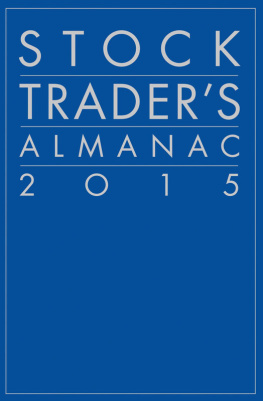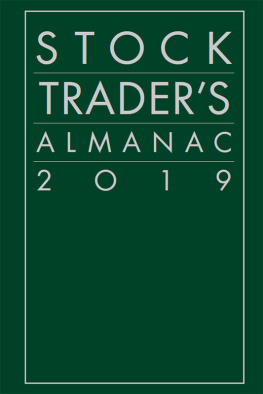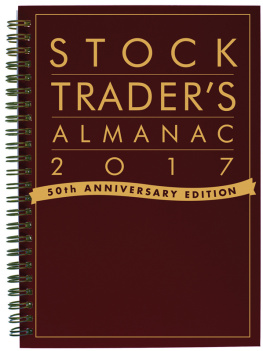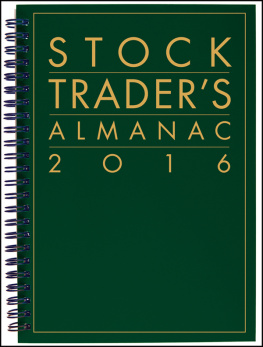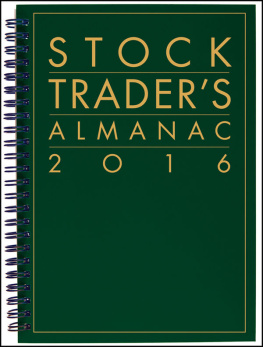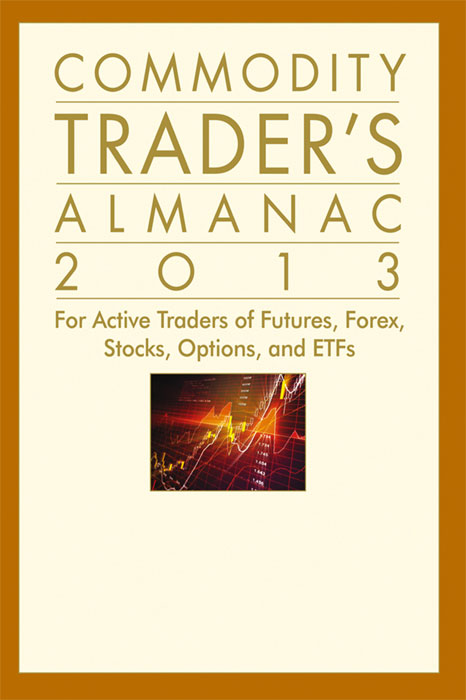
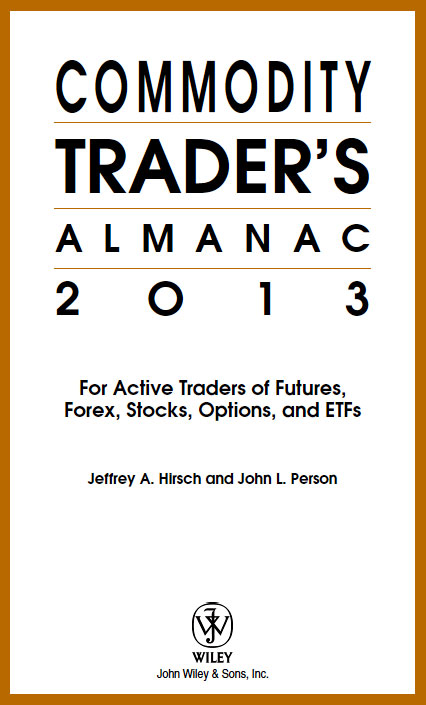
Copyright 2013 by John Wiley & Sons, Inc. All rights reserved.
Published by John Wiley & Sons, Inc., Hoboken, New Jersey
Published simultaneously in Canada
| Editor | Jeffrey A. Hirsch, stocktradersalmanac.com |
| Contributing Editor | John L. Person, nationalfutures.com |
| Director of Research | Christopher Mistal |
| Production Editor | Melissa Lopez |
| Charts, Data & Research | TradeNavigator.com |
| Additional Data | Pinnacledata.com |
No part of this publication may be reproduced, stored in a retrieval system, or transmitted in any form or by any means, electronic, mechanical, photocopying, recording, scanning, or otherwise, except as permitted under Section 107 or 108 of the 1976 United States Copyright Act, without either the prior written permission of the Publisher, or authorization through payment of the appropriate per-copy fee to the Copyright Clearance Center, 222 Rosewood Drive, Danvers, MA 01923, 978-750-8400, fax 978-646-8600, or on the web at www.copyright.com . Requests to the Publisher for permission should be addressed to the Permissions Department, John Wiley & Sons, Inc., 111 River Street, Hoboken, NJ 07030, 201-748-6011, fax 201-748-6008.
Limit of Liability/Disclaimer of Warranty: While the publisher and the author have used their best efforts in preparing this book, they make no representations or warranties with respect to the accuracy or completeness of the contents of this book and specifically disclaim any implied warranties of merchantability or fitness for a particular purpose. No warranty may be created or extended by sales representatives or written sales materials. The advice and strategies contained herein may not be suitable for your situation. You should consult with a professional where appropriate. Neither the publisher nor the author shall be liable for any loss of profit or any other commercial damages, including but not limited to special, incidental, consequential, or other damages.
Additionally, the risk of loss in trading futures and options can be substantial; therefore, only genuine risk funds should be used. Futures and options may not be suitable investments for all individuals, and individuals should carefully consider their financial condition in deciding whether to trade. For information on the CFTC Disclosure of Risk or the CFTC Consumer Advisory on Seasonality visit http://www.CFTC.gov and/or http://www.cftc.gov/enf/enfseasonaladvisory.htm .
For general information about our other products and services, please contact our Customer Care Department within the United States at 800-762-2974, outside the United States at 317-572-3993 or fax 317-572-4002.
Wiley also publishes its books in a variety of electronic formats. Some content that appears in print may not be available in electronic books.
For more information about Wiley products, visit our Web site at www.wiley.com . Also visit www.stocktradersalmanac.com for information about the Commodity Trader's Almanac and other market data.
ISBN: 978-1-118-15986-6 (cloth)
ISBN: 978-1-118-28228-1 (ebk)
ISBN: 978-1-118-28392-9 (ebk)
ISBN: 978-1-118-28634-0 (ebk)
INTRODUCTION TO THE SEVENTH EDITION
It is impossible to predict the future. That is why we rely on seasonal and historical analysis to help understand, or better yet, to remind us what price trends have occurred in the past and how often these trends perform. These patterns typically occur as a direct result of perennial supply and demand changes year after year. Every year has differences, from changes in monetary and fiscal policies to global macroeconomic situations to presidential election year cycles to extreme weather and other exogenous events.
2013 promises to be a dynamic year for commodity markets. No matter which party is elected, energy reform will likely be on the slate. Currently, we lack a national policy on fracking procedures, the process by which water and chemicals are injected into the earth to extract oil and natural gas. As of June 2012, policy decisions are in individual states' legislative hands. If we do see a shift toward more cleaner burning fuels, then natural gas may see ramped-up production, creating a shift in fossil fuel demand.
The first half of 2012 left the U.S. in a serious weather situation, wreaking havoc on farmers and ranchers. Earlier than normal hot and dry conditions reduced yields in corn and soybeans as well as creating massive wildfires throughout Colorado. The global economy, hurt by a European debt crisis and economic contraction in China, was partially to blame for decelerated U.S. economic growth. As a result, in June 2012, Ben Bernanke lowered the Federal Reserve's estimated gross domestic production (GDP) at 1.9 % to 2.4% from a previous estimate of 2.4% to 2.9%. The decelerating pace of job growth in the U.S. led the Federal Reserve to reaffirm and commit to keeping a near-zero interest rate policy through 2014. They even expanded their bond buying program, called Operation Twist, which was designed to add liquidity to the faltering financial system.
We believe we will have the perfect storm for continued volatility for stocks, bonds, safe haven instruments like gold and silver, agricultural markets, as well as foreign currencies in 2013 as a result of this ongoing global economic situation and the severe drought that has devastated the U.S. corn and soybean crops. The seasonal analysis provided in the Commodity Traders Almanac 2013 will likely prove to be a very valuable resource for active traders in these markets.
The new 2013 edition has several new additions and changes. We have added heating oil, including two new trades on pages 14 and 92 that replace the January short S&P trade and the October long corn trade; and advanced options strategies and trading tactics on pages 69. We have also added more exchange traded funds (ETFs) and exchange traded notes (ETNs). ETNs are similar to exchange traded funds, but differ in structure. ETNs are products that are issued as senior debt notes, while ETFs represent a stake in an underlying market.
The complete listing of all the Futures First Notice and Last Trading and Option Expiration Dates for all 20 markets covered on pages 118 and 119 also appears on the weekly planner pages and in the 2013 Strategy Calendar on pages 10 and 11. For the third Friday of the month, when equity, stock index, ETF, and ETN standard options expire, we have encircled the dates in the 2013 Strategy Calendar and added a witch to those dates in the weekly calendar pages. Three witches appear on Triple Witching day, the third Friday at the end of each quarter in March, June, September, and December when equity index futures expire. There are new case studies on pages 120123, including the crack spread, the NOB spread, and a new millennium sell in May trade using a vertical call spread, and the COT report is updated on pages 128130.
Many of the trades in 2012 were outstanding and there were the typical busts where trades did not fare so well, but the trader who was armed with the information packed in these pages had much better odds for overall success. Part of the path to better trading results lies in risk as well as trade management. Several tools may help traders uncover trades that are worthy of resources and consideration. Each featured trade shows the statistics of each year, allowing you to review past performance as a guide to what the average typical profit and loss has been for each specific trade.
Next page


